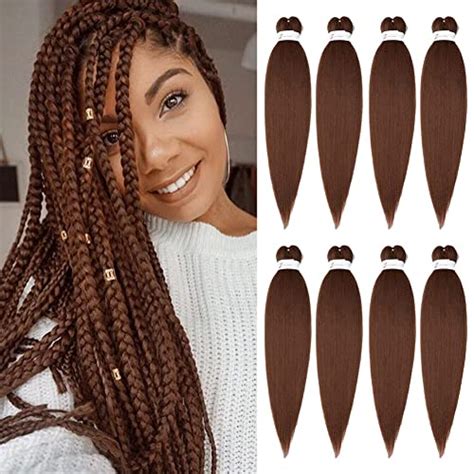Introduction
Braiding hair is a versatile and stylish way to express yourself. With the right hair extensions, you can create a variety of braids to match your mood and outfit. Whether you’re looking for a simple braid for everyday wear or a more elaborate style for a special occasion, there’s a braiding hair option out there for you.

Types of Braiding Hair
There are many different types of braiding hair available, each with its own unique look and feel. The most popular types of braiding hair include:
- Human hair: Human hair is the most expensive type of braiding hair, but it’s also the most natural-looking. Human hair can be styled and colored just like your own hair, so you can create a seamless look.
- Synthetic hair: Synthetic hair is a more affordable option than human hair, and it’s available in a wide range of colors and styles. Synthetic hair can be heat-styled, but it’s important to use low heat settings to avoid damaging the hair.
- Kanekalon hair: Kanekalon hair is a type of synthetic hair that is known for its soft, silky texture. Kanekalon hair is often used to create box braids and other cornrow styles.
- Yarn: Yarn is a unique and affordable option for braiding hair. Yarn comes in a variety of colors and textures, so you can create a truly unique look. Yarn can be difficult to braid, so it’s best to practice on a few strands before you start braiding your entire head.
How to Choose the Right Braiding Hair
When choosing braiding hair, there are a few things to keep in mind:
- The type of braid you want to create: Some types of braiding hair are better suited for certain types of braids than others. For example, human hair is ideal for creating natural-looking braids, while synthetic hair is better for creating more elaborate styles.
- The length of your hair: The length of your braiding hair will determine the length of your braids. If you have short hair, you’ll need to use longer braiding hair to create longer braids.
- The color of your hair: If you want your braids to blend in with your natural hair, choose braiding hair that is the same color as your hair. If you want your braids to stand out, choose braiding hair that is a different color than your hair.
How to Braid Hair
Braiding hair is a skill that takes practice. With a little patience, you’ll be able to master the basics of braiding and create beautiful braids on yourself and others.
Here are the steps on how to braid hair:
- Start with clean, detangled hair: Dirty, tangled hair will be more difficult to braid and will result in less-than-perfect braids.
- Section your hair: Section your hair into three equal strands.
- Cross the left strand over the middle strand: Take the left strand and cross it over the middle strand.
- Cross the right strand over the new middle strand: Take the right strand and cross it over the new middle strand.
- Repeat steps 3 and 4: Continue crossing the left and right strands over the middle strand until you reach the end of your hair.
- Secure the braid: Tie the end of the braid with a rubber band or hair tie.
Tips for Braiding Hair
Here are a few tips for braiding hair:
- Use a good quality braiding hair: Good quality braiding hair will be easier to braid and will last longer.
- Start with small sections of hair: Braiding small sections of hair will help you create tighter, more even braids.
- Keep your hair taut: Keep your hair taut as you braid to prevent the braids from becoming loose.
- Don’t be afraid to experiment: There are many different ways to braid hair. Experiment with different techniques to find the ones that you like best.
Braided Hairstyles
There are many different braided hairstyles to choose from, including:
- Box braids: Box braids are a popular protective style that can be worn for weeks or even months at a time. Box braids are created by sectioning the hair into small squares and braiding each square individually.
- Cornrows: Cornrows are a type of braid that is created by braiding the hair close to the scalp. Cornrows can be worn in a variety of styles, including straight back, side-swept, and even into shapes like hearts and stars.
- French braids: French braids are a type of braid that is created by braiding the hair from the top of the head to the bottom. French braids can be worn on their own or used to create more elaborate hairstyles.
- Dutch braids: Dutch braids are similar to French braids, but they are created by braiding the hair from the bottom of the head to the top. Dutch braids create a more voluminous look than French braids.
- Fishtail braids: Fishtail braids are a type of braid that is created by dividing the hair into two strands and crossing the strands over each other in a fishtail pattern. Fishtail braids create a beautiful, intricate look.
Braiding Hair Care
Braided hair requires special care to keep it looking its best. Here are a few tips for caring for braided hair:
- Wash your hair regularly: Wash your braided hair every 2-3 weeks with a gentle shampoo and conditioner. Avoid using harsh shampoos or conditioners, as they can damage the braiding hair.
- Moisturize your hair: Braided hair can become dry and brittle, so it’s important to moisturize it regularly. Apply a leave-in conditioner or hair oil to your braids to keep them hydrated.
- Avoid heat styling: Heat styling can damage braiding hair, so it’s best to avoid using heat styling tools on your braids. If you must use heat styling tools, be sure to use low heat settings and apply a heat protectant spray to your hair.
- Take your braids down at night: Taking your braids down at night will help to prevent them from becoming tangled and matted.
Conclusion
Braiding hair is a versatile and stylish way to express yourself. With the right hair extensions and a little practice, you can create beautiful braids that will turn heads. Whether you’re looking for a simple braid for everyday wear or a more elaborate style for a special occasion, there’s a braiding hair option out there for you.
Tables
| Braiding Hair Type | Pros | Cons |
|---|---|---|
| Human hair | Natural-looking, Can be styled and colored like your own hair | Expensive |
| Synthetic hair | Affordable, Available in a wide range of colors and styles | Not as natural-looking as human hair, Can be damaged by heat styling |
| Kanekalon hair | Soft, silky texture, Often used to create box braids and cornrows | More expensive than synthetic hair |
| Yarn | Unique and affordable, Comes in a variety of colors and textures | Can be difficult to braid |
| Braided Hairstyle | Description |
|---|---|
| Box braids | Protective style that can be worn for weeks or even months at a time, Created by sectioning the hair into small squares and braiding each square individually |
| Cornrows | Braided close to the scalp, Can be worn in a variety of styles |
| French braids | Braided from the top of the head to the bottom |
| Dutch braids | Braided from the bottom of the head to the top, Create a more voluminous look than French braids |
| Fishtail braids | Created by dividing the hair into two strands and crossing the strands over each other in a fishtail pattern |
| Tips for Choosing Braiding Hair |
|—|—|
| Consider the type of braid you want to create |
| Consider the length of your hair |
| Consider the color of your hair |
| Tips for Braiding Hair |
|—|—|
| Use a good quality braiding hair |
| Start with small sections of hair |
| Keep your hair taut |
| Don’t be afraid to experiment |
